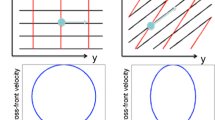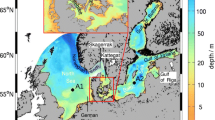Abstract
The ocean response is studied through the implementation of a numerical (POM, Princeton Ocean Model) with a constant Coriolis force, continuous vertical stratification, flat bottom and all boundaries closed. We considered four types of wind to force the model: Normal to the coastline; with Inertial path; in Fan shape and Realistic (sum of Inertial and Fan). The results of the numerical simulations show in each case the emergence of two counter rotating eddies in both sides of maximum wind and a cooling of sea superficial temperature. In the first case, the inertial wind adds asymmetry to the response, causing significant differences in the size and intensity of eddies. With the wind from a Fan-shape, the response remains similar to case one, but with more intense eddies and greater cooling. In the latter case with Realistic wind field, evident asymmetry is shown; it is used to explain in general, the dynamics produced by these winds.
Access provided by Autonomous University of Puebla. Download chapter PDF
Similar content being viewed by others
Keywords
These keywords were added by machine and not by the authors. This process is experimental and the keywords may be updated as the learning algorithm improves.
1 Introduction
For a long time the effect of wind stress on the circulation in coastal regions has been studied. It produces upwelling and increased primary biological production and is responsible for the formation of anticyclonic and cyclonic eddies at the ocean surface offshore. This phenomenon has been studied in different parts of the world, such as in the Gulf of Tehuantepec, the Gulf of Papagayo, northwestern Baja California, the Canary Islands and Cape Verde, to name a few places where winds blow from land to sea controlling coastal dynamics significantly, (Lavín et al. 1992).
Observations with satellite imagery and in-situ measurements have shown that the ocean response to these wind jets is not the same on both sides of the wind, taking a major component of asymmetry that can be noticed in the size and intensity of the eddies (Trasviña et al. 1995; Clark 1988; Lavín et al. 1992; Barton et al. 1993; Willett et al. 2006; Velázquez Muñoz et al. 2011). McCreary et al. (1989) mention that asymmetry between the eddies is due to the accumulation of cold water on the side of the cyclonic eddy caused by the difference in current directions (south) and countercurrent (opposite direction). Furthermore, Clark (1988) mentions that anticyclonic eddies can be strengthened by the introduction of negative vorticity by the inertial path, but only shows the antisymmetry in the displacement of the thermocline and symmetry in the Southern current of the surface layer of the ocean.
This chapter aims to provide new information and an explanation of the physical parameters involved in the asymmetric response of the ocean by the numerical model POM (Blumberg 1987) which is three-dimensional and solves the primitive equations of the ocean obtained from Navier-Stokes.
2 Methodology
2.1 Configuration and Implementation of the Numerical Model
The ocean is considered a flat-bottomed rectangular basin. The computational grid has a horizontal resolution of 5 km, with walls like closed boundaries, where there is free sliding, i.e. the sidewalls are simulating the earth. The initial condition is at rest, with temperature and salinity profiles varying only with depth. It is also assumed that the Coriolis parameter is constant.
This numerical model POM version 2k, is forced by four different types of wind, in the land-sea direction and a time period of 6 days. The first (Fig. 1a) is wind Normal to the boundary, similar to McCreary et al. (1989). In the second case (Fig. 1b); the wind opens in a Fan shape caused by an atmospheric pressure gradient. In the third case (Fig. 1c), the normal wind changes direction following an inertial path (curves to the right). Finally, the fourth type of wind (Fig. 1d), is generated by adding the two characteristics considered in the previous cases: the Fan shape caused by the atmospheric pressure gradient (case 2) and the inertial path curvature due to the Coriolis force (case 3), producing a wind with the same characteristics as shown by Steenburgh and Schultz (1998). Therefore, in this study the fourth type of wind was named Realistic wind. For the analysis of the ocean’s response to wind stress forcing (Normal, Inertial, Fan shape and Realistic), we used the numerical model output data: surface temperature (Ts), current velocity components integrated in the vertical; (UA, VA ) and the sea level \((\eta )\) in 2D layer and along a zonal section at 150 km parallel to the Northern shore. The aim is to identify which of these physical parameters respond asymmetrically, and to investigate which kind of wind contributes to a greater asymmetry of the ocean’s response.
3 Results
3.1 Ocean’s Response
Figures 2 and 3 show the response of the ocean’s surface to the wind stress on the third and sixth day of simulation, respectively.
In every case there is an asymmetrical surface response when the wind reaches its maximum intensity on the third day of simulation (Fig. 2). This can be observed in a cooling along the northern boundary and in the emergence of two eddies: one anticyclonic to the left and one cyclonic to the right. Both eddies are markedly different in size and shape. It also shows that the sea level rises in the anticyclonic and falls into the cyclonic. Similarly, on day 6, Fig. 3 shows that the characteristics of the ocean response are maintained, but with increasing in intensity. In the normal wind case (Fig. 2a) there is cooling near to the coast, where the cold water mass is displaced by the water current in the same direction as the wind jet, i.e. offshore.
Ocean’s response to the wind stress a normal to the coast, b fan, c inertial and d realistic. The color bar indicates the temperature in \(^{\circ }\mathrm{{C}}\), the contours correspond to the sea level (solid line represents elevation and dotted line, sinking) and the black arrows correspond to vertically integrated current. (The complete domain is not shown)
Figure 3a, shows the sea level for the case normal wind with an antisymmetric response because it has a positive displacement (anticyclonic region) and a negative displacement (cyclonic region) with the same magnitude, on day 6 (Fig. 3a) less cooling is observed, where cold water is displaced in the wind jet direction and slightly stretched by the anticyclonic eddy.
Figure 2b shows the ocean response to a fan shaped wind stress. One can observe the greater mass of cold water near the shore, in contrast with the case of normal wind. The sea level has a higher displacement in the cyclonic region than in the anticyclonic eddy.
For inertial wind (Figs. 2c, 3c), the ocean’s response shows a greater difference from all the other cases with respect to cooling and to the sea level displacements produced (higher elevation than lowering). It also highlights the difference in the shape one diameter of the eddies. The anticyclonic eddy is more intense than the cyclonic, being the cyclonic eddy very weak and not well defined. In the case of realistic wind (Figs. 2d, 3d) an asymmetrical response is shown, very similar to that obtained in the cases of normal wind and fan shaped with respect to surface temperature, eddy size, sea level displacement and vertically integrated current, where there is a slight weakening of the cyclonic vortex.
The asymmetric response to the realistic wind can be attributed to its inertial component. This result is consistent with the mechanism proposed by Clark (1988), who remarks that anticyclonic vortex strengthening, is caused by the inertial trajectory of the wind. This allows us to suppose that either the inertiality or the fan shape in the realistic wind could be important for the ocean’s response. In this case, the realistic wind was built with equal contribution of these two features, but apparently, the shape of the realistic wind is affected more by contribution of the Coriolis force than the atmospheric pressure gradient.
Finally, with respect to the meridional southern current integrated in the vertical at 150 km of the coast, it is shown that the wind stress generates a current by dragging the superficial water mass offshore (Fig. 4). This current produces a vacuum near the north boundary, which is occupied by the masses of water from both sides of the wind jet, producing two opposite currents (countercurrent anticyclonic and cyclonic). It also cooperates with the elevation of the subsurface cold water mass, generating cooling near the coast. In all four cases studied, the current’s velocity is higher than the velocity of the countercurrent, and the anticyclonic side countercurrent is greater than the current on the cyclonic side. The inertial wind contributes more to the southern velocity (the vertical), than the wind in all others cases.
4 Conclusions
This chapter provides an analysis of the ocean’s response for four different kinds of offshore normal wind (1. normal, 2. inertial, 3. fan shape and 4. realistic), using a three-dimensional numerical model.
Model results show, in all cases, an asymmetrical ocean response with respect to the sides and shape of emergence eddies, with cooling in the sea surface, where the mass of cold water is stretched with greater intensity by the anticyclonic eddy. It is also noted that there is higher elevation than sinking at sea level. These results show that the ocean’s response to normal wind (case 1) is similar to those shown by McCreary et al. (1989).
The inertial wind in contrast with the cases of normal wind, fan and realistic, provides greater asymmetry: higher cooling, strong meridional velocity and displacements of the sea level. These physical parameters show a greater change in the region of anticyclonic eddy than the cyclonic one.
References
Barton ED, Argote ML, Brown JP, Kosro M, Lavín MF, Robles JM, Smith RL, Trasviñia A, Vélez HS (1993) Supersquirt: dynamics of the of Tehuantepec Mexico Gulf. Oceanogr 6:23–30
Blumberg AF (1987) A description of a three-dimensional coastal ocean circulation model. American Geophysical Union, Washington DC
Clark AJ (1988) Inertial wind path and sea surface temperature patterns near the Gulf of Tehuantepec and Gulf of Papagayo. J Geophys Res 93:491–501
McCreary JP, Hyong SL, Enfield DB (1989) The response of the coastal ocean to strong offshore winds: with application to circulations in the Gulf of Tehuantepec. J Mar Res 47:81–109
Lavín MF, Robles ML, Argote ED, Barton R, Smith J, Brown M, Kosro A, Trasviña A, Vélez HS, García J (1992) Física del Golfo de Tehuantepec. Ciencia y Desarrollo. CONACyT. XVIII:Núm 103
Steenburgh WJ, Schultz DM (1998) The structure and evolution of gap outflow over the Gulf of Tehuantepec Mexico. Am Meteorol Soc 126:2673–2691
Trasviña A, Barton ED, Brown J, Vélez HS (1995) Offshore wind forcing in the Gulf of Tehuantepec, Mexico: the asymmetric circulation. J Geophys Res 100:20649–20663
Velázquez Muñoz FV, Martínez JA, Chavanne C, Durazo R, Flament P (2011) Wind-driven coastal circulation in the Gulf of Tehuantepec México. Ciencias Marinas 37:443–456
Willett, Leben RR, Lavín MF (2006) Eddies and tropical instability waves in the eastern tropical Pacific. Prog Oceanogr 69:218–238
Author information
Authors and Affiliations
Corresponding author
Editor information
Editors and Affiliations
Rights and permissions
Copyright information
© 2014 Springer International Publishing Switzerland
About this chapter
Cite this chapter
Bañuelos, A.D.O., Muñoz, F.Á.V. (2014). Forced Dynamics by Wind Normal to the Boundary. In: Klapp, J., Medina, A. (eds) Experimental and Computational Fluid Mechanics. Environmental Science and Engineering(). Springer, Cham. https://doi.org/10.1007/978-3-319-00116-6_26
Download citation
DOI: https://doi.org/10.1007/978-3-319-00116-6_26
Published:
Publisher Name: Springer, Cham
Print ISBN: 978-3-319-00115-9
Online ISBN: 978-3-319-00116-6
eBook Packages: Earth and Environmental ScienceEarth and Environmental Science (R0)








